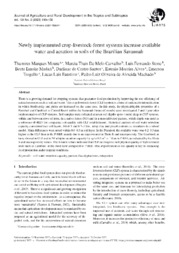Newly implemented crop-livestock-forest systems increase available water and aeration in soils of the Brazilian Savannah.
Newly implemented crop-livestock-forest systems increase available water and aeration in soils of the Brazilian Savannah.
Autoria: MOURA, T. M.; CARVALHO, M. T. de M.; STONE, L. F.; MADARI, B. E.; SANTOS, D. de C.; ALVES, E. M.; TROGELLO, E.; FAUSTINO, L. L.; MACHADO, P. L. O. de A.
Resumo: There is a growing demand for cropping systems that guarantee food production by improving the use efficiency of natural resources such as soil and water. The crop-livestock-forest (CLF) system is a form of sustainable intensification in which biodiversity and yields are increased on the same area. In this study, the physical-hydric properties of a Ferralsol and Cambisol in Central Brazil within the Savannah biome (Cerrado) were investigated 2 and 1 year after implementation of CLF systems. Soil samples were collected at seven soil depths up to 1 meter deep in CLF systems, within and between rows of trees, in a native forest (NF) and in a non-cultivated pasture, which was used as a reference (P-REF) for comparing soil quality with CLF establishment. Statistical analysis of soil water retention capacity considered two soil layers, 0.0-0.3 and 0.3-1.0 m, using clay and gravel contents as covariates in a mixed model. Main differences were noted within 0.0-0.3 m soil layer. In the Ferralsol, the available water was 0.2-0.3 mm higher in the CLF than in the P-REF, mainly due to an improvement in Theta R and microporosity. The Cambisol, in turn, showed in CLF and in NF a higher aeration capacity by up to 0.3 m3 m-3 than in P-REF, as indicated by the Theta S and macroporosity values. The S index values showed that CLF can improve soil physical quality of light textured soils such as Cambisol in the short term compared to P-REF. This improvement in soil quality is key to sustaining food production under tropical conditions.
Ano de publicação: 2023
Tipo de publicação: Artigo de periódico
Unidade: Embrapa Arroz e Feijão
Palavras-chave: Cerrado, Eucalipto, Eucalyptus, ILPF, Integração, Integração lavoura-pecuária-floresta, Pastagem, Pastures, Retenção de Água no Solo, Soil water retention
Observações
1 - Por padrão são exibidas publicações dos últimos 20 anos. Para encontrar publicações mais antigas, configure o filtro ano de publicação, colocando o ano a partir do qual você deseja encontrar publicações. O filtro está na coluna da esquerda na busca acima.
2 - Para ler algumas publicações da Embrapa (apenas as que estão em formato ePub), é necessário ter, no celular ou computador, um desses softwares gratuitos. Sistemas Android: Google Play Livros; IOS: iBooks; Windows e Linux: software Calibre.
Acesse outras publicações
Acesse a Base de Dados da Pesquisa Agropecuária (BDPA) para consultar o acervo completo das bibliotecas da Embrapa.

